| Article ID | Journal | Published Year | Pages | File Type |
|---|---|---|---|---|
| 2680717 | Primary Care Diabetes | 2016 | 7 Pages |
•Cardiovascular disease (CVD) agent use in newly treated type 2 diabetes was studied.•Substantial CVD agent utilisation was noted.•Younger aged subjects were less likely to receive guideline recommended therapies.•It is possible that the use of statins and aspirin might be further optimised.
AimsTo describe the drug utilisation patterns of aspirin, antihypertensives, vasodilators, and statins in a cohort of newly treated type 2 diabetes subjects previously unexposed to CVD agents.MethodsA population-based retrospective cohort study was conducted using a national pharmacy claims database of newly treated type 2 diabetes subjects aged 40 years or older. Data on the use of aspirin, antihypertensives, vasodilators, and statins 1 year after antidiabetic agent initiation were analysed. Poisson regression with a robust error variance was used to estimate adjusted relative risk (RRadj) and 95% CIs between socio-demographic and treatment factors on CVD agent use.ResultsOver a 2-year period (2008–2009), 6093 subjects were identified. One year after antidiabetic agent initiation, 82% of the study population received at least one CVD agent, with 54% receiving aspirin, 64% receiving antihypertensives, 6% vasodilators, and 62% receiving statins. Subjects aged 40–49 years were significantly less likely than those aged 60–69 years to receive CVD agents (RRadj 0.83, 95% CI 0.80–0.87). Over 40% of subjects received antihypertensives without aspirin and statins, while 30% of subjects on statins did not receive aspirin.ConclusionsSubstantial CVD agent utilisation was noted 1 year after antidiabetic agent initiation. Being aged younger than 60–69 years was associated with decreased utilisation of CVD agents.
